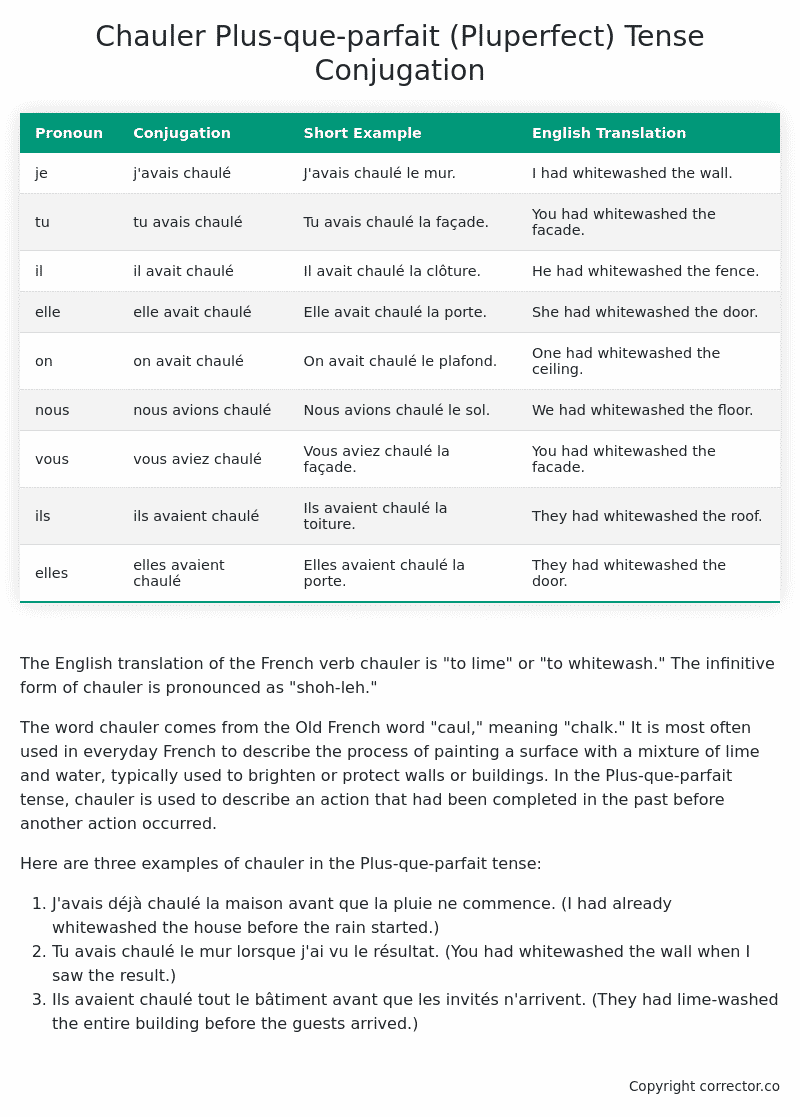Plus-que-parfait (Pluperfect) Tense Conjugation of the French Verb chauler
Introduction to the verb chauler
The English translation of the French verb chauler is “to lime” or “to whitewash.” The infinitive form of chauler is pronounced as “shoh-leh.”
The word chauler comes from the Old French word “caul,” meaning “chalk.” It is most often used in everyday French to describe the process of painting a surface with a mixture of lime and water, typically used to brighten or protect walls or buildings. In the Plus-que-parfait tense, chauler is used to describe an action that had been completed in the past before another action occurred.
Here are three examples of chauler in the Plus-que-parfait tense:
- J’avais déjà chaulé la maison avant que la pluie ne commence. (I had already whitewashed the house before the rain started.)
- Tu avais chaulé le mur lorsque j’ai vu le résultat. (You had whitewashed the wall when I saw the result.)
- Ils avaient chaulé tout le bâtiment avant que les invités n’arrivent. (They had lime-washed the entire building before the guests arrived.)
Table of the Plus-que-parfait (Pluperfect) Tense Conjugation of chauler
| Pronoun | Conjugation | Short Example | English Translation |
|---|---|---|---|
| je | j’avais chaulé | J’avais chaulé le mur. | I had whitewashed the wall. |
| tu | tu avais chaulé | Tu avais chaulé la façade. | You had whitewashed the facade. |
| il | il avait chaulé | Il avait chaulé la clôture. | He had whitewashed the fence. |
| elle | elle avait chaulé | Elle avait chaulé la porte. | She had whitewashed the door. |
| on | on avait chaulé | On avait chaulé le plafond. | One had whitewashed the ceiling. |
| nous | nous avions chaulé | Nous avions chaulé le sol. | We had whitewashed the floor. |
| vous | vous aviez chaulé | Vous aviez chaulé la façade. | You had whitewashed the facade. |
| ils | ils avaient chaulé | Ils avaient chaulé la toiture. | They had whitewashed the roof. |
| elles | elles avaient chaulé | Elles avaient chaulé la porte. | They had whitewashed the door. |
Other Conjugations for Chauler.
Le Present (Present Tense) Conjugation of the French Verb chauler
Imparfait (Imperfect) Tense Conjugation of the French Verb chauler
Passé Simple (Simple Past) Tense Conjugation of the French Verb chauler
Passé Composé (Present Perfect) Tense Conjugation of the French Verb chauler
Futur Simple (Simple Future) Tense Conjugation of the French Verb chauler
Futur Proche (Near Future) Tense Conjugation of the French Verb chauler
Plus-que-parfait (Pluperfect) Tense Conjugation of the French Verb chauler (this article)
Passé Antérieur (Past Anterior) Tense Conjugation of the French Verb chauler
Futur Antérieur (Future Anterior) Tense Conjugation of the French Verb chauler
Subjonctif Présent (Subjunctive Present) Tense Conjugation of the French Verb chauler
Subjonctif Passé (Subjunctive Past) Tense Conjugation of the French Verb chauler
Subjonctif Imparfait (Subjunctive Imperfect) Tense Conjugation of the French Verb chauler
Subjonctif Plus-que-parfait (Subjunctive Pluperfect) Tense Conjugation of the French Verb chauler
Conditionnel Présent (Conditional Present) Tense Conjugation of the French Verb chauler
Conditionnel Passé (Conditional Past) Tense Conjugation of the French Verb chauler
L’impératif Présent (Imperative Present) Tense Conjugation of the French Verb chauler
L’infinitif Présent (Infinitive Present) Tense Conjugation of the French Verb chauler
Struggling with French verbs or the language in general? Why not use our free French Grammar Checker – no registration required!
Get a FREE Download Study Sheet of this Conjugation 🔥
Simply right click the image below, click “save image” and get your free reference for the chauler Plus-que-parfait tense conjugation!

Chauler – About the French Plus-que-parfait (Pluperfect) Tense
Tense Formation
Common everyday usage patterns
Sequencing of past events
Background information
Hypothetical or reported speech
Interactions with other tenses
Summary
I hope you enjoyed this article on the verb chauler. Still in a learning mood? Check out another TOTALLY random French verb conjugation!


